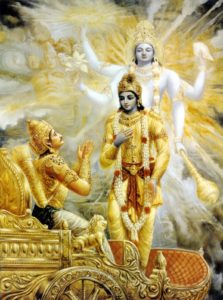Please Respect the Spiritual and Cultural Significance of Yoga
by: Ranjan Vadlamani
Oṁ Śrī Gurubhyo Namaḥ!
(My Salutations to the Revered Teacher)
I want to mention early on that this is a sensitive post. It is not directed at any specific person or studio. It is a reflection of what I’ve observed at many places, with many practitioners, leading me to believe the original roots of Yoga are slowly suffocating.
Let me first start by stating this fact: Going to a studio with dim lights for a flow class does not make one a “Yogi” and to understand why, we need to understand the word Yoga and the sacred place it holds in the hearts of the people who practice Yoga beyond āsana, or beyond posture.
Yoga means Union, and not just any union, but a Union with the “Paramātman,” the Supreme Soul, or with God.

self (limited with the identification of the body, emotions, thoughts and desires associated with them and experiencing pain and pleasure through the lens of this
limited means) and The Self (unlimited, seeing God in yourself, in everything in this universe and treating everyone and everything with kindness and compassion, goes beyond pleasures and pains experienced by the limited
self) and initiating Arjuna in the path of Yoga to see the soul and realize his true Self.
Here, Arjuna is identifying himself with his body and his emotions and not knowing his soul before Lord Kṛṣṇa teaches him Yoga.
A Yogi is an enlightened being who has known their true Self and doesn’t identify their “self” with the self that they are. Yes, as confusing as this statement might sound, it is important we understand why there is one Self that is capitalized and one that is not. The self without the lowercase “S” is still a bound soul experiencing the turbulences caused by mind, and the “Self” is liberated; it is beyond pain, beyond suffering, beyond desires, beyond devotion itself. We can think of the Self as a fragment of the Paramātman that resides within all of us, but most people are unaware of this and instead identify themselves with their bodies, their thoughts, and their professions, among other things.
Let me examine some terms here :
Ātman – Soul
Paramātman – Supreme soul/God
Yoga – A communion of the self with Paramātman after the sense of the self disintegrates and becomes the Self.
If one has not seen their soul, one is not a Yogi. Fortunately, there are some beautiful terms in Sanskrit that can help one understand where they are in the process of their evolution in reaching that Union, because “Yoga is not a practice, Yoga is not a state of mind, Yoga is divine relationship that cannot be explained in words, it can only be felt and experienced.” – Lord Shiva in Sri Vijnana Bhairava Tantra.
Here are a few more terms which I would highly recommend be used when discussing Yoga practice.
- Sādhana – Practice
- Sādhaka – Practitioner
- Tapasyā – Practice that is a little more evolved than your regular Sādhana, which builds heat in the system (and no, not a practice that happens in a heated room). The heat is the internal Agni or fire which has started piercing through the granthi’s or the knots that are stopping your progress.
- Tapasvin – is that student who has evolved into building that internal heat, that Agni, but has not yet experienced that divine communion.
- Yogi/Yogin/Yogini – Someone who went beyond Tapasyā and achieved a state of “Samādhi.”
My request to all the Sadhāka/Tapasvin is to be cautious in claiming that one has achieved Samādhi or experienced it after a specific asana. Samādhi has multiple levels in it, but it is in most doctrines the highest state of experience. It is said that once one has experienced Samādhi, no other experience comes even remotely close to that divine communion state. This is a word that is usually reserved for highly revered spiritual Guru.
I also request practitioners try to understand all the limbs of Yoga beyond postures and notice the differences between Pratyāhāra (sense withdrawal), dhāraṇā (One-Pointed Focus), Dhyāna (Extreme Concentration) and Samādhi (Returning to the State of Origin). These terms do vary based on which school of Yoga Philosophy one ascribes to, however their meanings fundamentally remain consistent for the most part. Familiarity with these concepts and their differences will only contribute to your understanding of Samadhi, and of the true purpose of Yoga.
Please understand that saying things like, “I attained Samādhi doing a certain asana,” can be very disrespectful to a Sadhāka/Tapasvin to whom Yoga exists beyond posture practice and remains a truly sacred practice. Please save this sanctity.
Disrespect can also come in various other usages in this industry. Yes, I called Yoga, our beloved Yoga, an industry, and this is not geared towards the Sadhāka or Tapasvin who are working hard to maintain its integrity but to other studios and teachers who use “Yoga” as a money making marketing gimmick. Not so long ago, I saw a video on Youtube where people were practicing “Goat Yoga,” and another group was involved in “Wine Yoga” and even more disappointing adaptations. Please refrain from practicing Goat Yoga, Alcohol Yoga, etc. It might feel as if it is harmless, but it is doing harm by masking and making light of the true purpose of Yoga.
I’d like to remind everyone that Yoga has no color and no religion – yoga is for anyone who wishes to know themselves. I truly believe that this is an important discussion to have. I humbly request help in moving forward with correct knowledge, in making sure we all go back to basics. Not knowing the basics is like building a tower on top of an unstable foundation, leaving a tower that will surely collapse.
I want to thank my teacher Jessica (who is going above and beyond to make Yoga accessible to larger audience and sharing the knowledge in it’s true form) for providing me a platform to express my opinions, I also want to thank my friend Susan who took time out of her busy schedule to proof read my article and discuss with me a few of her wonderful experiences and adding her invaluable insights to apply the appropriate tone and tune to my words.
asato mā sadgamaya, – From Untruth, lead me to truth
tamaso mā jyotirgamaya, – From darkness, lead me towards light
mṛtyormā’mṛtaṃ gamaya. – From death, lead me towards immortality

About Ranjan:
Ranjan’s first yoga practice was in his elementary school in India when he was 4 and it was just a fun activity. He later traded his Yoga practice for other sports and later on for his pursuit in higher education. He started getting deep in spirituality when he was 24. He says he can’t explain exactly what happened but his faith got stronger out of nowhere and with his adolescent ages spent in India, he feels lucky to have the exposure to various religions, cultures and spirituality all around him and wanted to understand more about them and thus began his Yoga journey.
He first started trying different classes like beginners, flow etc., but felt like something was missing, and because of his earlier exposure, he could quickly identify that the missing aspect was that most of the Yoga practices are just limited to a good body stretch and Asana and were missing the spiritual and authentic Yogic practices that actually helps a student introspect more.
He then took a Mysore Ashtanga workshop led by Kino in which he met Jessica, and started taking Ashtanga classes under Jessica’s expert guidance. He took private meditation classes, breathing classes with Jessica and realized that he found his mentor, guide, teacher, a sister who can help him on his path.
He quotes the reference from “Vijnana Bhairava Tantra” which defines a Yogi (a meditator) as “One who closely examines the relationship between the subject and the object, one who sees and the one being seen. Someone who examines his connection with himself and the object that he is connected to.”
One of his favorite quotation is “The body benefits from movement and the mind benefits from stillness!”. Ranjan is on a path to finding himself, shedding his layers of conditioning and spreading the knowledge he gains to others who are interested in this path.

Thank you for posting this well articulated article and the sentiment of disappointment with what is happening to “yoga” as it is practiced here in the west.
Great article.